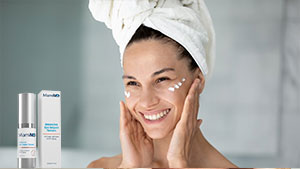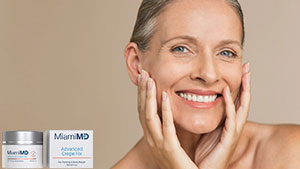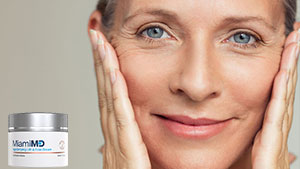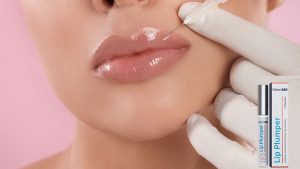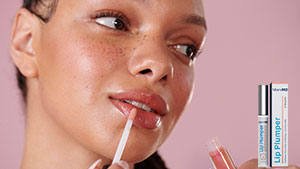What Is Sodium Ascorbyl Phosphate And What Does It Do?
Developing a useful and efficient skin care routine requires being able to read an ingredient list and understanding exactly what it can do for you. Some of the ingredients that are the most beneficial for your skin can also be some of the most difficult to pronounce.
Take sodium ascorbyl phosphate, for example.
While its name may sound intimidating, this ingredient is one that can take your skin to the next level when you know how to use it.
At Miami MD, we developed our skin care line to provide “functional beauty” that anyone can use. Let’s learn more about what sodium ascorbyl phosphate is and what it can do for your skin.
Sodium Ascorbyl Phosphate Basics
Although the name may be tricky to pronounce, sodium ascorbyl (say it like us-CORE-bill) phosphate is just a different form of ascorbic acid/l-ascorbic acid…more commonly known simply as vitamin C. You may see it shortened on an ingredient list to “SAP.”
But what makes it different from vitamin C?
The most important difference is also the strength of sodium ascorbyl phosphate. Just like vitamin C, SAP is considered water-soluble. What this means is that it is able to break down in the presence of water and absorb into the skin.
However, vitamin C is known as “bioactive,” which means that it is already in a form that is readily accepted and used by the skin without needing to be broken down or changed on a chemical level.
Sodium ascorbyl phosphate, on the other hand, does require conversion once it begins to be absorbed into the body.
While the conversion process does make SAP slightly less active and effective, that is also what attracts a lot of people to the ingredient. For many people with sensitive skin, vitamin C can be too harsh. Using sodium ascorbyl phosphate instead can help the skin in similar ways without having as high of a likelihood of causing irritation or redness. It’s a great way for people who couldn’t ordinarily try vitamin C to be able to enjoy many of the same benefits.
The other major difference between SAP and vitamin C is its stability. In this regard, SAP is superior to the typical l-ascorbic acid that is found in most skin care products. If you’ve ever owned a vitamin C-based serum, you’ve probably noticed that they come in dark or opaque bottles or containers.
They were designed that way for a reason. L-ascorbic acid is actually very unstable and breaks down quickly in the presence of direct light or oxygen. That means that the vitamin C product that you purchase and the vitamin C product that you’re using a month or so later can be drastically different in their effectiveness.
Sodium ascorbyl phosphate doesn’t have that issue and is considered to be stable in the presence of light and oxygen.
What Can Sodium Ascorbyl Phosphate Do For Your Skin?
Just like ascorbic acid, sodium ascorbyl phosphate is most well known for its antioxidant properties. If you’re unfamiliar with the term, antioxidants help stop or slow down the oxidation process in the body.
The main goal of this is to fight off molecules known as free radicals, which are created as a response to environmental factors (like UV radiation) and stress. The problem with free radicals is that they are unstable, as they are lacking an electron.
In searching for that electron, they can pull them away from stable molecules in the body, causing damage that can lead to premature signs of aging and even cancer. Antioxidants stop that search by either volunteering one of their own electrons or breaking the free radical down entirely.
One of the most exciting benefits of sodium ascorbyl phosphate is its ability to help people with acne-prone skin. This is attributed to the fact that SAP has antimicrobial properties.
Why is that important?
In addition to an overproduction of sebum (the natural oil produced by the body), the presence of Propionibacterium acnes (usually seen abbreviated as P. acnes) is one of the top factors in treating acne. When using sodium ascorbyl phosphate to help treat and control acne, it helps to reduce the amount of bacteria on the skin without irritating it as other acne products can.
These benefits start even at a 1% concentration, and many over-the-counter SAP-containing skin care products out there have up to 10% SAP on their ingredient lists.
However, the trouble with SAP is that, other than its acne-treating properties, it hasn’t been studied nearly as much as ascorbic acid has. Most benefits have been determined because of its relationship with vitamin C, but there is more research to be done to conclusively show that it can do what many people claim it can.
How To Incorporate Sodium Ascorbyl Phosphate Into Your Skin Care Routine
If you’re ready to start adding SAP into your current skin care routine, the good news is that there are more and more products out there that include this potentially game-changing ingredient.
The best way to use SAP is in a serum.
These products normally have more of the ingredient than a lotion or a cream would which, considering it is slightly less effective than full ascorbic acid, is an added benefit.
In terms of where this serum should fall in your routine, it’s generally recommended that you apply serums after your skin has been cleansed (and toned, if that is part of your routine) but before you have applied moisturizer.
If you use more than one serum, you’ll want to apply them from the lightest consistency to the thickest to increase the amount that can be absorbed. Always let your products dry to the touch before moving on to the next one.
Sodium ascorbyl phosphate should be applied in the morning, especially if you use retinol in the evenings, as they can cancel each other out. It also works best when applied separately from benzoyl peroxide, which is another common acne-fighting ingredient, as it can cause SAP to oxidize and significantly decrease its effectiveness.
However, SAP can and should be used with ingredients like vitamin E, ferulic acid, and hyaluronic acid, which can help your skin look not only more even but also more hydrated and radiant.
Just like any new skin care ingredient, it’s best to work it into your existing routine slowly.
Start with once or twice a week to make sure that your skin doesn’t react to it and, if you have extra sensitive skin, you may want to do a patch test before applying it to your entire face.
When Is Ascorbic Acid the Better Choice?
While sodium ascorbyl phosphate is an impressive, effective ingredient, especially for people with sensitive skin or acne concerns, there are some cases that you’ll want to invest in an ascorbic acid-based skin care product instead.
For instance, treating hyperpigmentation (dark/age spots). This is one of the areas that vitamin C has been studied directly, and its impressive, skin-changing benefits have been confirmed.
Miami MD’s Dark Spot Corrector is one of the products that take advantage of vitamin C’s ability to minimize and even potentially erase dark spots.
We included ascorbic acid as one of the product’s main ingredients, alongside other ingredients known to help not only with hyperpigmentation but also to restore the skin’s youthful luster.
Alpha-arbutin helps inhibit the amount of tyrosinase in the system, which is one of the catalysts responsible for the production of melanin — which is what dark spots are made out of, otherwise known as pigment.
Resveratrol is a polyphenol-rich antioxidant, which helps brighten the skin. And finally, both glycolic acid and kojic acid (which fall into the alpha-hydroxy acid, or AHA, category), help to exfoliate the skin. This removes the top layer of dead skin cells, helping the skin to naturally appear brighter and more youthful as the appearance of dark spots fades away.
Vitamin C can also be used effectively as part of a targeted oral supplement that helps treat the hair, skin, and nails from the inside out.
Miami MD’s Total Beauty Matrix can be taken the morning, with or without food, and combines ascorbic acid with other, beneficial ingredients including biotin, a proprietary mineral complex, saw palmetto, lysine, and hydrolyzed collagen peptides to help boost collagen production, fight back against visible signs of aging, and create firmer, radiant skin.
In Summary
Sodium ascorbyl phosphate is likely one of the more beneficial skin care products out there that you haven’t heard of. If you’re looking for a way to fight off visible signs of aging and acne concerns without as much potential for skin irritation, give SAP a try.
However, if your skin can handle it, ascorbic acid (or vitamin C) may be the way to go. For all of your skin care needs, and the ability to incorporate them in a way that promotes functional beauty, turn to Miami MD.
It’s our goal to help you look your best.
Sources:
Sodium ascorbyl phosphate – C6H6Na3O9P | NIH

